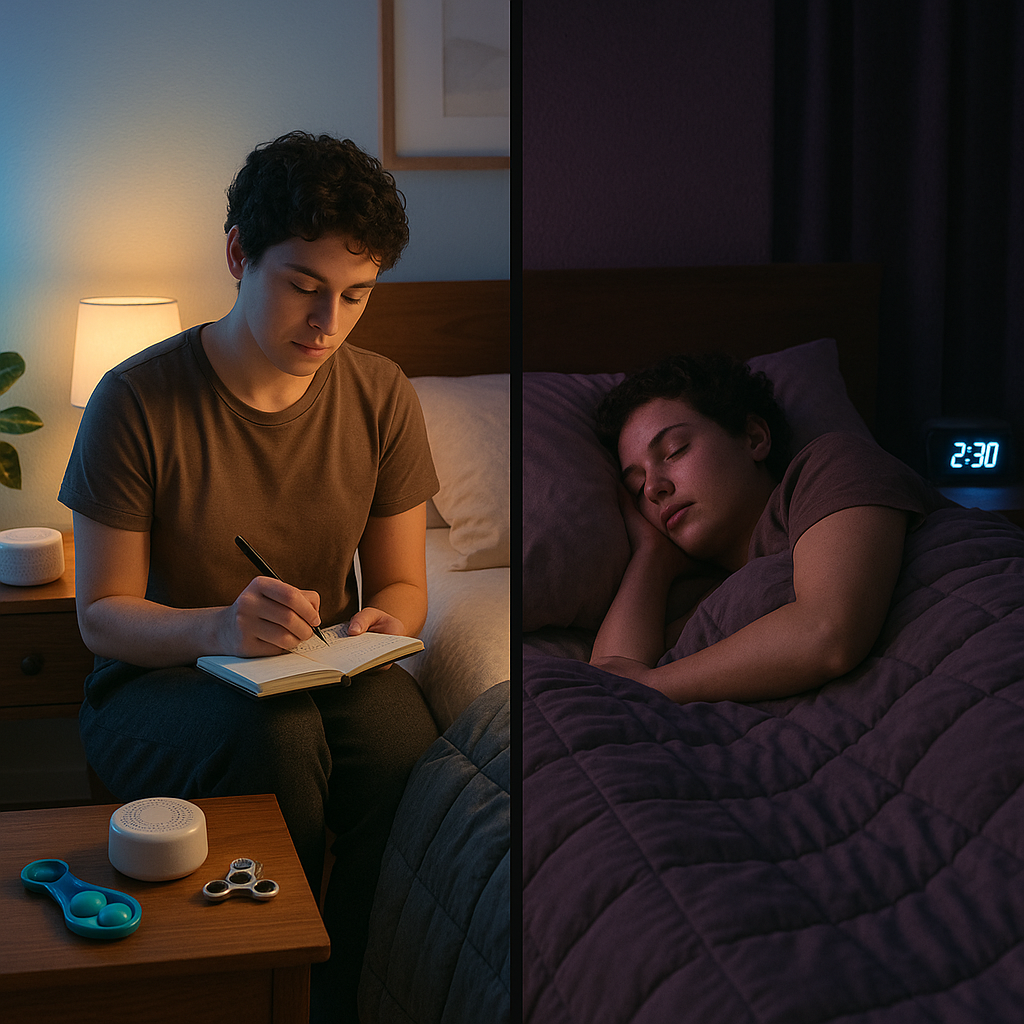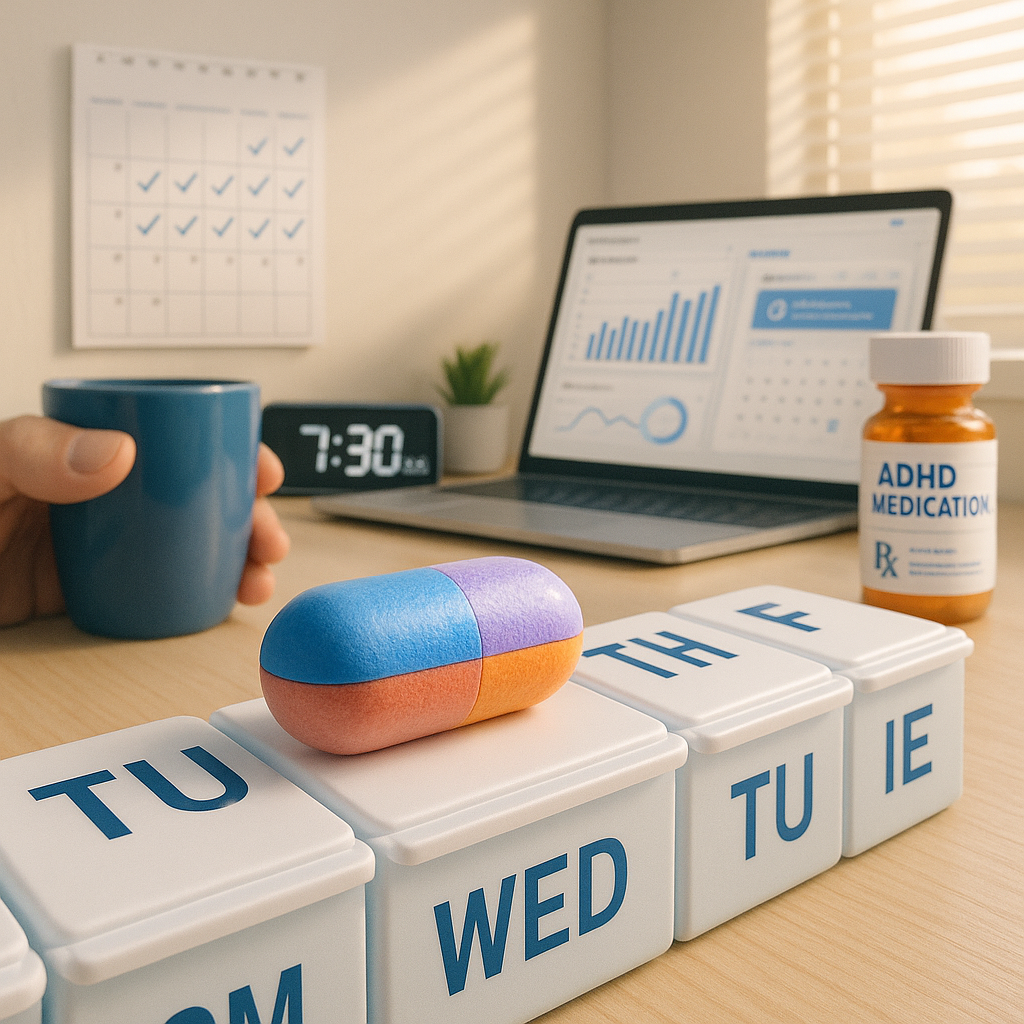Key Takeaways
Quality sleep is not a luxury for neurodivergent minds. It is a foundation for daily functioning, especially for those living with ADHD. Restful nights require more than generic advice; they demand strategies tailored to unique brain wiring, individual body clocks, and fluctuating energy cycles. Below are the essential takeaways to help you build sleep routines that truly honor your neurodivergent rhythm.
- Honor neurodivergent sleep patterns instead of forcing conformity: Traditional sleep hygiene rules rarely suit ADHD brains, which often follow nonstandard sleep cycles. Aligning your routine with your natural circadian pattern is often more effective than imposing “normal” schedules that don’t match your biology.
- Personalize bedtime rituals for consistency, not perfection: Rather than chasing rigid routines, focus on cues that signal your brain it’s time for rest, like dim lights, sensory wind-downs, or calming audio. Stick with the practices that reliably work for you.
- Address the root of ADHD fatigue, not just surface symptoms: Chronic sleep debt amplifies inattention, emotional swings, and executive dysfunction. Prioritizing deep and restorative sleep is a non-negotiable strategy for symptom management and resilient energy.
- Adapt to your natural rhythms, rather than battling against them: Many neurodivergent individuals are natural night owls or experience delayed sleep phases. Embracing these patterns and timing major tasks or sleep intervals to your natural peaks can transform your relationship with rest.
- Understand the impact of ADHD medication on sleep: Stimulant medications and some non-stimulants can disrupt sleep onset and quality. Regularly track your sleep, maintain open communication with your healthcare provider, and make adjustments to evening routines or medication timing as needed.
- Spot and manage sleep debt before burnout arises: Neurodivergent minds can accumulate sleep debt quickly and recover more slowly. Recognize early signs, such as emotional dysregulation, memory lapses, or persistent fatigue, and carve out protected periods for rest and recovery.
- Improved sleep powers better symptom control: Quality, restorative sleep can directly reduce core ADHD symptoms, stabilize mood, and optimize cognitive performance. A well-rested brain lays the groundwork for more productive, creative, and enjoyable days.
Ultimately, understanding and respecting your unique sleep needs makes rest a powerful ally. Sleep is not about “fitting in” or chasing perfection. It’s about fueling the brilliance that comes from your one-of-a-kind neurodivergent mind. Let’s explore the real strategies that turn sleep from a point of struggle into a springboard for focus, calm, and growth.
Introduction
If you’ve ever felt that standard sleep advice falls short when faced with ADHD restlessness or relentless midnight mind-racing, you are in good company. For neurodivergent minds, quality rest requires much more than checking items off a conventional to-do list. It means tuning into your personal rhythms, honoring the reality of your brain’s operating system, and recognizing why ADHD-related fatigue lingers despite the best generic hacks.
Genuinely restorative sleep with ADHD begins with rewriting the rulebook. Instead of striving for “perfect” routines or idealizing typical bedtimes, success comes from working with your own circadian rhythm, designing custom wind-down rituals, and actively managing sleep debt. These strategic shifts can turn sleep challenges into opportunities for stronger symptom control and daily revitalization. Discover actionable approaches that transform sleep from a persistent frustration into a source of clarity, energy, and well-being.
Understanding the ADHD-Sleep Connection
The Neurobiological Link
ADHD’s impact on sleep reaches far beyond restlessness. At its core, the ADHD brain navigates sleep differently due to specific neurobiological traits. Studies show individuals with ADHD commonly experience a delayed circadian rhythm, meaning their natural urge to sleep arises 1.5 to 2 hours later than in neurotypical populations. This isn’t a matter of bad habits; it is your brain’s internal clock following its natural program.
Additionally, neurotransmitters such as dopamine and norepinephrine, which are already regulated differently in ADHD, play significant roles in the sleep-wake cycle. An imbalance in these chemicals can fuel racing thoughts, restlessness, and even nighttime energy spikes, complicating sleep onset and maintenance.
Common Sleep Challenges in ADHD
The hurdles neurodivergent individuals face are not imaginary; they are well-documented physiological realities. Many people with ADHD encounter:
- Delayed Sleep Phase Syndrome (DSPS): An internal clock that is 2-3 hours behind typical societal schedules.
- Sleep Onset Insomnia: Difficulty winding down and shifting from wakefulness to sleep, often with overactive thinking.
- Sleep Maintenance Issues: Frequent awakenings during the night and challenges returning to sleep.
- Paradoxical Responses: Feeling more alert and energized at night than during daytime hours.
These challenges often produce a self-reinforcing cycle. Poor sleep heightens ADHD symptoms, which in turn can make falling and staying asleep even harder. Recognizing this cycle is the vital first step toward sustainable change.
Customizing Your Sleep Environment
Moving beyond standard recommendations, shaping your sleep environment to suit your neurodivergent needs can make a significant difference.
Physical Environment Optimization
The ideal bedroom for an ADHD mind might look very different from what traditional advice suggests. Tailor your space by considering these evidence-based, ADHD-friendly adjustments:
- Install smart lighting to gradually dim before bedtime, helping cue your body for rest.
- Use white noise or ambient nature sounds if silence feels uncomfortable or distracting.
- Keep tactile fidget tools or textured objects close by to manage pre-sleep restlessness.
- Designate a “landing pad” (a bedside notebook and pen) for capturing racing thoughts, so your mind can release them before sleep.
Accept that your optimal sleep environment may differ from conventional wisdom and prioritize what actually supports your best rest.
Temperature and Sensory Considerations
Many neurodivergent individuals experience heightened sensory sensitivities, which can profoundly impact sleep comfort. To create an optimal sensory environment, pay attention to:
- Room temperature: Keep your bedroom slightly cool, ideally between 65-68°F (18-20°C) for most people.
- Bedding textures: Select sheets, blankets, and sleepwear that align with your specific sensory preferences. Thread count and material comfort matter more than industry trends.
- Weighted blankets: These can help manage physical restlessness and promote a sense of safety for some.
- Air quality: Ensure good airflow and consider air purifiers or open windows where safe. Fresh air boosts both daytime alertness and nighttime relaxation.
By attending to these environmental factors, you’ll set the stage for more reliable and restorative sleep.
Building ADHD-Friendly Sleep Routines
Creating routines that support neurodivergent needs requires flexibility, imagination, and self-compassion.
Timing Strategies
Forcing yourself onto traditional sleep schedules rarely yields good results with ADHD. Instead, treat your body’s natural tendencies as your guide.
- Determine your necessary wake time first, then plan your ideal bedtime by working backward from that anchor.
- Build in a buffer, often 30 minutes or more, for the inevitable challenges of transitioning from activities to rest.
- Use time-blocking techniques for your evening routine, but stay open to adjustments if your day unfolds differently.
- Experiment with biphasic (split) sleep if it aligns with your natural rhythm, such as two shorter sleep periods instead of one long stretch.
Adjust these timing strategies until you find a pattern that genuinely supports both rest and daily functioning.
Evening Wind-Down Techniques
The usual pre-sleep advice, often centered on stillness or predictability, may not fit ADHD brains craving engagement or stimulation. Instead, consider wind-down practices that respect your need for both novelty and structure.
- Active relaxation: Light movement routines, such as yoga, stretching, or gentle dance, that help channel excess energy.
- Productive wind-downs: Engage in light, enjoyable tasks (like tidying or coloring) that provide satisfaction and signal the close of day.
- Brain dumps: Dedicate time to jotting down tomorrow’s to-dos or lingering thoughts, freeing your mind.
- Dopamine tapering: Transition gradually from high-stimulus activities (like gaming or intense social media use) to calmer ones, rather than abrupt cutoffs.
Recognizing that engagement is vital, these practices deliver stimulation without overstressing the mind, clearing a mindful path toward sleep.
Managing Sleep Disruptors
A sustainable sleep strategy for ADHD requires proactive handling of common disruptors, especially technology use and medication timing.
Technology and Screen Time
Blanket device bans are rarely successful for neurodivergent adults. Instead, develop mindful technology habits.
- Combine blue light filters with deliberate content choices, such as switching to soothing podcasts or calming music near bedtime.
- Designate device-free intervals or specific “tech wind-down” routines while keeping lines open for important connections.
- Reduce mental load by automating reminders to put away devices or dim screen brightness at set times.
- Use technology as a sleep tool when appropriate. Meditation apps, sleep stories, or white noise generators can enhance the wind-down process.
Personalizing your approach to tech can greatly reduce its disruptive role while leveraging its benefits for relaxation and focus.
Medication Timing
Many individuals with ADHD take medications that affect alertness, sometimes making sleep more challenging. Optimizing medication timing requires collaboration and careful self-observation.
- Keep a journal to track how medications, especially stimulants, impact your sleep patterns.
- Discuss with your healthcare provider whether a small afternoon dose improves early evening executive function, which can impact your ability to wind down.
- Note changes in sleep when medications are adjusted, and advocate for alternatives if side effects compromise rest.
- Establish clear routines for taking, adjusting, or pausing medication according to your treatment plan.
Approaching medication as one part of a personalized sleep system helps you harmonize neurochemical support with restorative rest.
Conclusion
Delving into the ADHD-sleep connection transforms nightly frustration into a nuanced understanding of neurobiology and self-care. By recognizing delayed circadian rhythms, honoring sensory preferences, and designing personalized sleep routines, individuals with ADHD can create environments and practices that feel intuitive and sustainable. Smart lighting, adaptable wind-down rituals, and acceptance of unconventional patterns empower you to work in harmony with your unique mind.
Purposeful technology use and thoughtful medication management further strengthen your sleep strategy, creating a well-rounded system that honors both brain chemistry and personal agency. Ultimately, sleep for neurodivergent individuals is not about perfection or compliance with norms; it is an ongoing process of experimentation, self-discovery, and compassion. Approach rest as a dynamic ally, and you unlock the foundation for improved mood, sharper cognition, and the fullest expression of your creative and professional strengths.
Looking ahead, those who embrace their neurodivergent needs and adapt sleep strategies accordingly are not just improving rest. They are building the resilience and clarity required to thrive in work, relationships, and self-expression. The path to thriving lies not in trying to “fix” what makes you different, but in equipping yourself with systems that celebrate it. Rest well. Your brilliance depends on it.





Leave a Reply